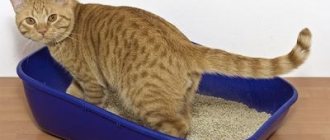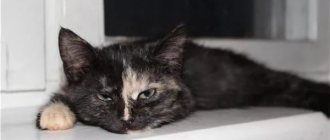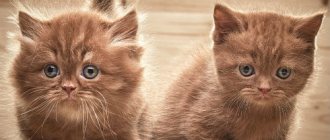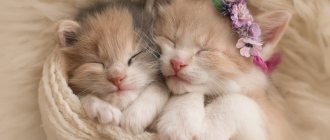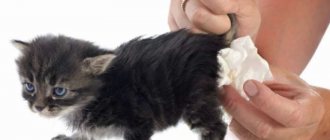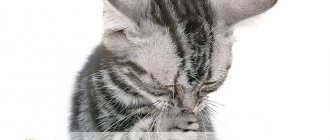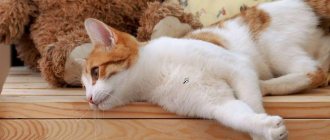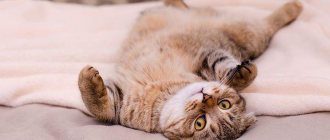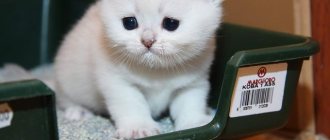If your furry pet has no health problems, his stool does not contain any additional inclusions. In appearance it is dense and formed. Mucus found in a cat's feces, blood discharge or diarrhea signal to the owner that problems have arisen in the animal's body, often of a serious nature. After independently studying the symptoms, it is recommended to seek help from a veterinary clinic or hospital, take the prescribed tests, and then the doctor will be able to prescribe effective treatment for the disease.
The main causes of mucus
It's hard not to notice the deviation. Mucus in appearance resembles translucent or white viscous substances in feces. There may be a small amount of them, but it also happens that the discharge completely covers the cat feces. In each case, this is a signal to quickly contact a specialist, since pathological changes occur in the cat’s body. The appearance of mucus is caused by the following reasons:
- the appearance of worms;
- bacterial infections and diseases;
- binge eating;
- functional failure of the digestive system;
- fatty diet;
- stressful situations;
- allergic reactions of the body;
- wool in the gastrointestinal tract;
- reaction to medications;
- weakened immunity;
- a sharp change in the food menu;
- intoxication;
- clogged intestines.
A fatty diet in an animal can lead to such a disturbance in the appearance of feces.
All these various reasons contribute to a malfunction of the body, thereby causing mucus and scarlet blood in the cat’s stool. A person cannot influence their occurrence and it is almost impossible to independently determine why a kitten has foreign discharge and transparent ichor in its stool. However, with such impurities and additional symptoms, it is clearly noticeable that the animal is sick.
Predisposing factors
The causes of diarrhea are very diverse, some of them pose a serious danger to the life and health of your pet. Animals adopted from cat shelters are at particular risk: they often suffer from feline panleukopenia, giardiasis and coccidiosis. Viral infections are very dangerous, as they greatly weaken the already not very “powerful” body of children.
However, much more often, much more “harmless” factors lead to the appearance of diarrhea, including nutritional characteristics.
Therefore, we will look at the effect of diet:
- So, a very common cause of diarrhea in kittens is sudden “perturbations” in their diet. Remember that young animals are very sensitive to dietary changes! Therefore, when taking a kitten from a shelter or from another breeder, be sure to ask how and what it ate. You should gradually accustom your pet to new food by adding new food to its old diet. There is no need to rush, as otherwise your pet will be guaranteed diarrhea.
- Overfeeding. Kittens need to be fed often, but in small portions. Their intestines are simply unable to digest large quantities of food.
- Intolerance to certain foods. If you notice that after some food your cat immediately begins to diarrhea, do not use it in the future.
- Kitten eating spoiled food. Often it is not the owners’ direct fault: if a pet gets into the trash can, it will almost inevitably eat “something wrong.” The natural result of this will be diarrhea.
- Cow's milk. Many breeders firmly believe that cats cannot live without it. This is a dangerous misconception. Cow's milk contains a lot of lactose, and most kittens' bodies cannot digest it. Their endocrine glands do not produce the required amount of this enzyme. Because of this, milk that enters the kitten’s digestive tract is not digested, but curdles. A lot of casein clots are formed, richly saturated with microflora. And all this “wealth” begins to rot right in the kitten’s intestines. It is not surprising that he quickly develops thin, mucous diarrhea.
Poisoning
Note that diarrhea is a common consequence of poisoning with organic and inorganic poisons. They should be suspected first of all when the kitten has not only diarrhea, but also vomiting. The effect of toxins on the digestive tract of kittens often leads to the destruction of its epithelial layer. Mucous inclusions in fecal matter are accumulations of exfoliated and destroyed epithelial cells. In veterinary practice, cases of poisoning with various types of household chemicals are very common. It should be kept out of the reach of pets and small children! Poisoning is also common in kittens that have free access to the outdoors.
During a walk, kids can eat anything, and it’s good when all they end up with is diarrhea. Salts of heavy metals can generally lead to the rapid and sudden death of your pet! In addition, yellow mucous diarrhea in case of poisoning indicates liver damage.
How to recognize?
The manifestation of the following symptoms indicates the following diseases:
- If a cat poops mucus, this is a consequence of exceeding the dose of vitamins.
- Bloating and loose stools in your pet indicate intolerance to certain foods in the diet.
- Lumps of mucus in diarrhea, vomiting, and weight loss indicate inflammatory processes in the gastrointestinal tract.
- Loose stools with white inclusions, weakness, lethargy, nausea, discharge from the eyeballs and nose indicate that a viral infection is spreading throughout the body.
- Modified feces with mucus, restlessness of the pet, pain in the abdominal area are considered the main symptoms of colitis or enteritis.
- Feces acquire a pungent, stinking odor, and there is mucus and blood present—signaling inflammation or oncology.
- Liquid stool consistency with dark streaks, vomiting, and rapid loss of body weight indicate the presence of worms in the body.
- If the feces have acquired green or yellow shades, increased appetite, flatulence, bloating - reasons to check the condition of the cat's pancreas.
Only if your pet takes antihelminthic medications can you not worry about mucus in the stool. This sign is not considered a pathology and may persist for the first few days after the procedure. The cat goes to the toilet this way simply because its body is cleaning itself.
Dangerous symptoms
A pet's health can be determined in part by its behavior. If a cat has black stool, but the pet is active and affectionate as usual, and willingly accepts play, most likely the cause of the change in stool is physiological factors. However, the presence of a number of symptoms against the background of black stool indicates serious problems and requires immediate medical consultation:
- Stool with blood clots. This is a clear sign of heavy internal bleeding. His life depends on the speed of helping the purr.
- Unusual pet behavior. If a cat meows pitifully and the scream intensifies when you try to touch his stomach, this indicates a pain syndrome. An additional sign of pain is a slight trembling throughout the animal’s body.
- Temperature increase.
- Vomiting and/or false urges.
- Weakness. A bad sign is the fluffy's apathy, when he shows no interest in what is happening and simply lies indifferently.
- Deterioration of appetite, complete refusal of food.
- Extreme thirst or refusal to drink water.
- Frequent urge to urinate.
- Pale gums.
- Formation of wounds and bruises on the body.
Loose, black stool is called melena and is a sign of heavy bleeding.
The animal may be prescribed IVs to replenish lost fluid.
When should you see a doctor?
If an animal with such a symptom begins to look sick, then it needs a visit to the doctor.
Important symptoms are also vomiting, blood streaks in the stool, frequent diarrhea, frequent urination, increased thirst, increased body temperature, unhealthy appearance, complete or partial refusal to eat. It is recommended to monitor the cat's condition for the first few days. If the situation does not change and all the symptoms persist or develop with renewed vigor, then you must definitely contact your attending veterinarian in order to get tested and prescribe the appropriate treatment for your furry pet.
Prevention of diarrhea
Bacterial and viral diseases are combated through preventive vaccination. The vaccination schedule is selected individually and depends on the age of the pet. For preventive purposes, it is necessary to use antihelminthic drugs, and also to test feces annually for the presence of parasites. Be sure to monitor your animal’s hygiene and regularly sanitize its litter tray, water and drinking bowls.
Do not feed your animal expired or poorly prepared food. You should not give your kitten raw water or unpasteurized cow's milk. Feed at the same time every day, and try to follow the diet. Store chemicals where animals cannot find them. Cats love to eat grass, so it is not recommended to keep poisonous plants in the house.
Basic tests as a diagnostic method
In order to diagnose the disease, the veterinarian may be interested in:
- The cat's attempts to rub its butt on the carpets. This behavior indicates an existing problem with the anal sinuses.
- Injuries, blows, bites in this area. May cause great discomfort for the animal.
- Detailed description of your pet's diet.
- Swallowed objects, ingestion of spoiled food.
If the doctor needs to clarify something, the animal may be sent for an x-ray.
Upon receipt of all the answers of interest, the veterinarian immediately makes a diagnosis or prescribes additional procedures. So, he can send the cat for feces, urine, blood, and examination of the rectum by swallowing a probe under anesthesia. By analyzing the profile of chemical elements in the bloodstream, it is possible to understand what is happening in the body. Colonoscopy and x-rays of organs are performed as prescribed by the doctor. As a result of receiving answers, effective and efficient treatment of the disease is selected.
Treatment of the disease
There can be no self-medication when such symptoms are detected. After testing, medications and preventive measures are prescribed to cure the disease. On the first day, it is recommended to unload the body from food; only water is allowed. Further, the following drugs are used for each ailment separately:
- Viral infections. Treat with subcutaneous injection of antiviral serum.
- Bacterial diseases. Only antibiotic therapy will help.
- Poisoning and intoxication. The medication "Atoxil" is prescribed.
- Worms. Antihelminthic drugs solve this problem.
- Intestinal microflora disorders. Probiotics are needed for a course of at least 10 days.
- Spasms. Antispasmodic drugs are prescribed, especially for acute pain.
After treatment, cats easily return to normal, and the functioning of the intestines and esophagus improves. The animal goes to the toilet painlessly, for the most part, it does not secrete white mucus and there is no transparent ichor in the impurities. To summarize, we can say that blood and mucus in a cat’s stool are considered pathological secretions and signal the development of the disease. This cannot be left to chance; you must consult a specialist if additional symptoms appear.
Diagnostic techniques
To understand what exactly happened and why your pet has diarrhea with mucus and blood, veterinarians use complex diagnostic tests:
- Carrying out blood and urine tests.
- Microscopic examination of stool. This method is used for suspected helminthic infestations and protozoal infections.
- X-ray and ultrasound examination of the abdominal cavity.
- In complex and doubtful cases, examination of scrapings from the intestinal walls is useful. They are obtained during endoscopy.
- It will probably be necessary to inoculate the resulting samples on nutrient media, since using this technique it is possible to accurately determine the type of pathogen, which is important when further prescribing treatment.
